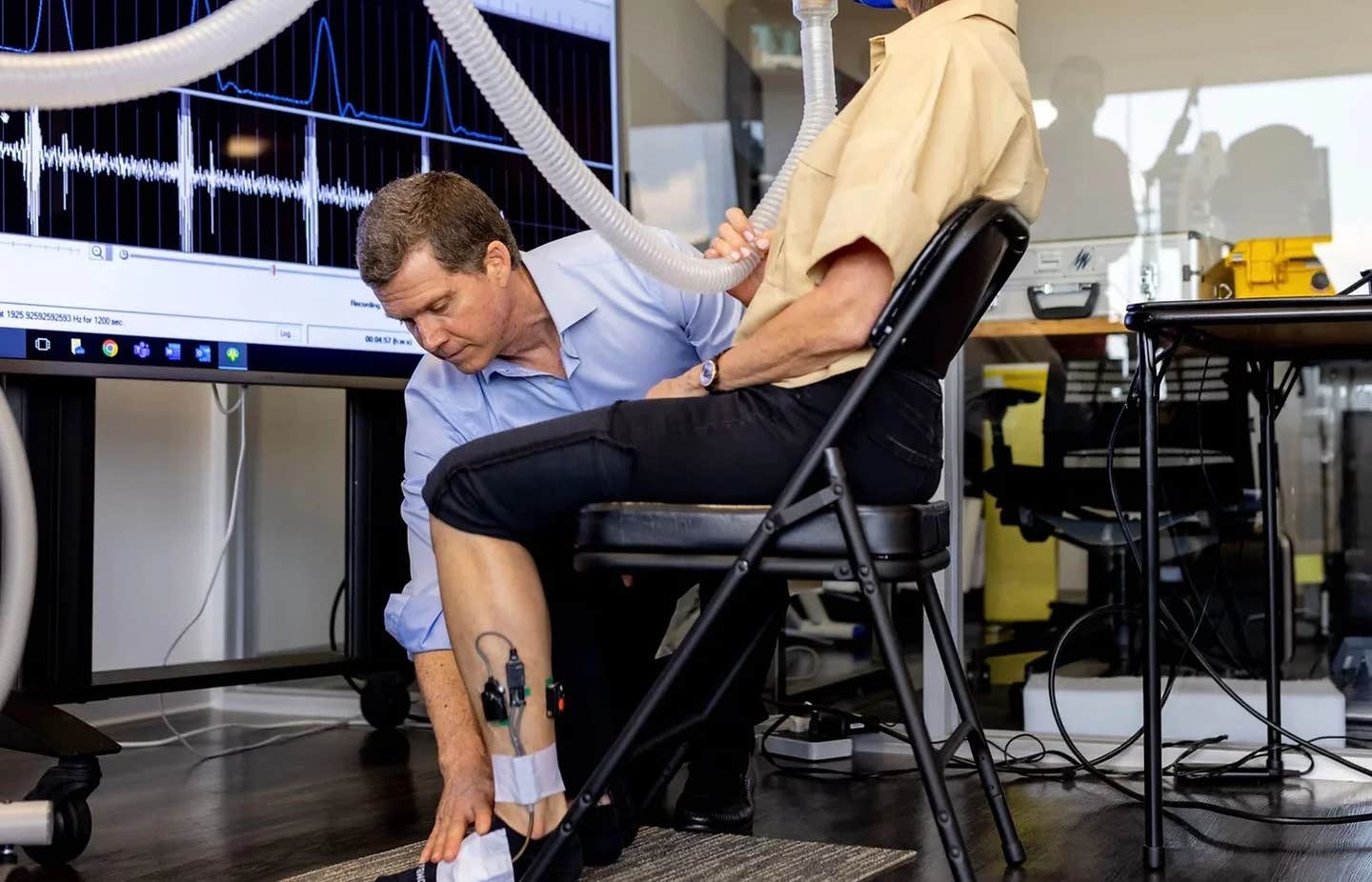Exercising this small leg muscle burns fat for hours, even while sitting
A small calf muscle may unlock big health benefits—lowering blood sugar and fat levels—just by moving it while seated.

An overlooked muscle in your calf may hold the key to better blood sugar and fat metabolism—without leaving your chair.(CREDIT: University of Houston)
For years, the body’s largest lean tissue—skeletal muscle—has been underestimated in its role in managing metabolic health. Despite its size, it contributes surprisingly little to blood sugar and fat breakdown when you’re at rest. But now, new research is revealing that one small muscle buried deep in the calf might hold an outsized key to better health. And all it takes is a simple movement while sitting.
Marc Hamilton, a health and human performance professor at the University of Houston, has spent years asking a bold question: Can you unlock the metabolic potential of a single muscle to fight the damage of too much sitting?
His answer, supported by rigorous data and published in iScience, points to the soleus—a slow-twitch muscle just below the calf that makes up only about 1% of body mass. When used in a specific way, this underappreciated muscle has the power to drive whole-body improvements in blood sugar and fat metabolism.
The slow muscle with hidden strength
The soleus has a unique profile. It’s rich in slow-twitch muscle fibers, which are great for endurance and use oxygen efficiently. In fact, roughly 88% of its fibers fall into this category—far more than most other muscles in the body. Because of this, it can stay active for long periods without getting tired.
Unlike other muscles that burn through stored glycogen, the soleus prefers to use blood-borne fuels like glucose and fats. That’s important, because tapping into these circulating nutrients means you don’t need to deplete internal energy stores. This rare trait allows it to contract steadily for hours without fatigue.
Its vascular system and enzyme profile also set it apart. Studies show the soleus has high levels of glucose transporters and oxidative enzymes but very little of the glycolytic machinery found in more explosive muscles. This makes it ideal for long, slow energy burn—something that could be harnessed for improving metabolic health in a way other muscles cannot.
Related Stories
How one motion can change metabolism
That’s where Hamilton’s innovation comes in. He designed a movement called the "soleus pushup," or SPU, to activate this specific muscle in a controlled and sustained way. It’s not exercise in the traditional sense. You do it while sitting, with your feet flat on the floor. You raise your heel while keeping the ball of your foot down, then let the heel fall back naturally.
It may look like a seated calf raise, but what’s happening inside is different. The muscle contracts in a way that stimulates its unique slow-twitch fibers without tapping into the limited glycogen supply. That’s the secret to keeping it going for long periods. During SPU activity, oxygen use spikes, and the soleus becomes a localized furnace for glucose and fat.
“We never dreamed that this muscle has this type of capacity,” Hamilton said. “It's been inside our bodies all along, but no one ever investigated how to use it to optimize our health, until now.”
This muscle is so energy-efficient and resistant to fatigue that even untrained volunteers could keep the contractions going for hours. And the payoff? When participants did the SPU while sitting, they showed massive improvements in key health markers.
Outperforming traditional health strategies
In trials, the benefits of this small muscle’s activation were staggering. After just a few hours of SPU contractions, participants had 52% less blood glucose fluctuation after a glucose drink. Their insulin response dropped by 60%, meaning the body required far less effort to keep sugar levels stable.
Even more, the rate of fat metabolism doubled during fasting periods between meals. Levels of very-low-density lipoprotein triglycerides, a type of fat linked to heart disease, also dropped. These numbers weren’t just statistically significant—they beat results from other popular methods, including intermittent fasting, regular walking, and even significant weight loss.
“All of the 600 muscles combined normally contribute only about 15% of the whole-body oxidative metabolism in the three hours after ingesting carbohydrate,” Hamilton explained. “Despite the fact that the soleus is only 1% of body weight, it is capable of raising its metabolic rate during SPU contractions to easily double, even sometimes triple, the whole-body carbohydrate oxidation.”
These results come during a time when chronic conditions like diabetes are surging. By 2010, over half of American adults had prediabetes or diabetes. For those over 65, the number was closer to 80%. Add to that the fact that many adults sit for 9 to 11 hours a day, and it becomes clear why a seated muscle-activating strategy like SPU could matter so much.
Rethinking inactivity and exercise
Many people assume that exercising once a day is enough to counteract hours of sitting. But the body doesn’t work that way. Most skeletal muscle stays metabolically quiet during inactivity. When you sit, even though muscle makes up a large part of your body weight, it contributes very little to glucose and fat breakdown.
“We are unaware of any existing or promising pharmaceuticals that come close to raising and sustaining whole-body oxidative metabolism at this magnitude,” Hamilton said.
Traditional health advice tends to focus on whole-body movement and burning more calories overall. But Hamilton’s team flipped that idea. Instead of chasing higher energy burn, they focused on activating the right muscle in the right way, for a long time.
For decades, scientists have been trying to activate small but powerful oxidative tissues like brown fat to boost metabolism. But brown fat makes up less than 1% of total body mass and is difficult to activate consistently. Hamilton’s work shows the soleus may offer a more practical path, with a similar potential for raising local metabolism and influencing full-body health.
A new tool for everyday health
The SPU isn’t meant to replace exercise or encourage constant sitting. Instead, it’s a tool to use during the time people are already seated. Unlike walking or running, which rely on quick glycogen depletion and short bursts of effort, the SPU taps into the body’s blood-borne fuel supply steadily and efficiently.
This approach is especially valuable for older adults and those with metabolic diseases who can’t always engage in intense activity. Because the SPU doesn’t require special equipment or a trip to the gym, it can be practiced at home or work, offering a realistic way to combat the hidden harms of long sitting sessions.
Hamilton pointed out that it’s not just a simple movement but a very specific one that requires training to get right. At present, his lab uses wearable devices to help participants optimize the SPU. Future publications, he said, will focus on teaching the public how to perform the movement without needing lab-grade tools.
"This is the first concerted effort to develop a specialized type of contractile activity centered around optimizing human metabolic processes," Hamilton said.
What started as an idea about one overlooked muscle may now be one of the most promising strategies to reduce the risk of chronic illness in an aging and sedentary population. Whether you're in an office chair, a classroom, or your living room, the soleus pushup could be a simple but powerful step toward better health.
Note: The article above provided above by The Brighter Side of News.
Like these kind of feel good stories? Get The Brighter Side of News' newsletter.
Joseph Shavit
Head Science News Writer | Communicating Innovation & Discovery
Based in Los Angeles, Joseph Shavit is an accomplished science journalist, head science news writer and co-founder at The Brighter Side of News, where he translates cutting-edge discoveries into compelling stories for a broad audience. With a strong background spanning science, business, product management, media leadership, and entrepreneurship, Joseph brings a unique perspective to science communication. His expertise allows him to uncover the intersection of technological advancements and market potential, shedding light on how groundbreaking research evolves into transformative products and industries.



